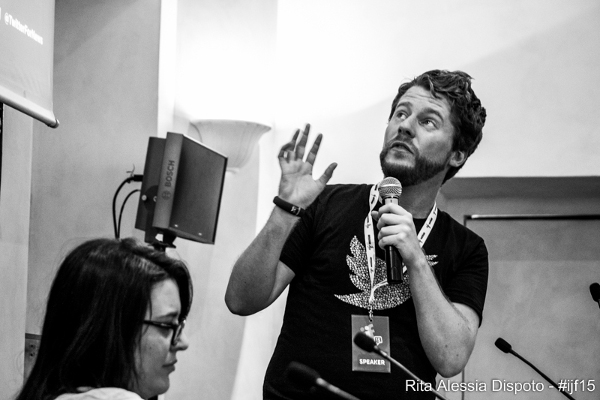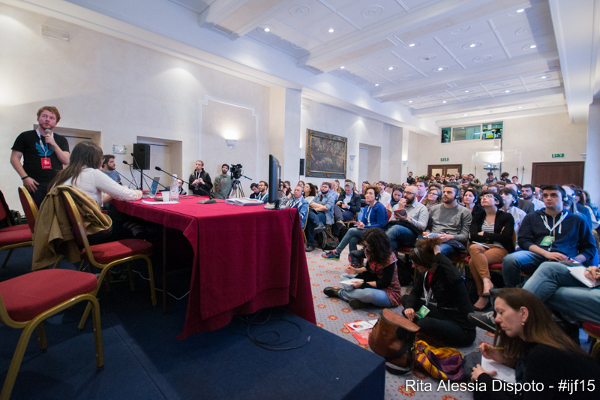Ten years ago, when the new Pope was elected, very few people were seen photographing the event with their smartphone. But in 2013, when Francis became Pope, the situation was different.
Almost everyone had a smartphone in their hands, a powerful tool that was used to record and share that event with the rest of the world.
“This changed everything especially for journalists, because everyone can become a source of information. You can tap into it to have a source of information not previously available”, explains Jérome Tomasini, Head of News and Politics at Twitter France.
Together with Livia Iacolare, manager media partnerships at Twitter Italy, Tomasini led a Twitter Masterclass that discussed verification, curation and content discovery on Twitter.
But what makes Twitter so unique?
According to Tomasini, it is the engagement and the reporting that can be done in real time not only by journalists, but also bystanders. The fact that on Twitter everyone can tell what’s happening in real time became clearly visible during events such as the Arab Spring protests or the Charlie Hebdo attack. The logo with the “Je suis Charlie” motto also demonstrated how Twitter can initiate conversations that often go beyond Twitter itself, as tweets can be easily embedded into other websites. The power of Twitter also lies in the global conversations, initiated by more than 288 million monthly active users who send 500 million tweets per day.

Demystifying Twitter in four steps
In four simple steps, Iacolare and Tomasini helped inexperienced Twitter users to understand the basic functions of the platform.
Step 1: Detect
What is really important for beginners is to use Twitter to find news. The way to do it is to optimise followers and create lists.
“You need to be strategic about who you follow. Follow your sources; ask yourself who are the people and who are the institutions you could get insights from. Also follow your colleagues and foreign counterparts, especially if they are more experienced on Twitter. You will learn from example”, advises Tomasini.
Defining the right professional contacts can be done in various ways, including through the website Followerwonk, which allows users to search for contacts via their bio, or through exploring lists created by media organisations.
Creating a personal list is also a good tool that makes it easier for a beginner to follow relevant contacts. You can create a private list, which will not be visible to anyone and will allow you to monitor groups of people without necessarily having to follow them. Or you can create a public list: users will receive a notification and you will enrich your contacts circle.
But lists are not the only way to detect relevant information. Using Tweetdeck and filtering makes the life of a journalist much easier, according to Iocolare. Searches by country, geocode, visuals and even engagement can help journalists go around the clutter of tweets easily.
Iacolare also warns that sometimes Twitter can create controversial content and journalists should always check even the smallest details to make sure it is credible.
Enabling notifications and following trends is also a way for journalists to stay on track with the latest developments and breaking news.
Step 2: Engage
When it comes to engagement, building a credible and respectable public identity is what can help any journalist distribute their work, demonstrate their expertise or promote their media outlet. As individuals who use Twitter can be easily identified, Tomasini reminds the audience that journalists should be aware that everything is visible to the general public and even if you decide to delete certain tweets, some followers might have taken screenshots.
“Twitter is like having a microphone in a room where nobody knows you”, says Tomasini.
Attracting an audience can be done only with regular tweeting that stays close to one’s personal identity and is done in a interesting and accessible way.
“Your goal on Twitter is to be ambitious – it can help you stand out from the crowd and become the best in the field. Don’t be afraid to share good content even if it doesn’t come from your newsroom – this enables you to build trust.”

Step 3: Report
When it comes to real life reporting, live tweeting is what Tomasini considers the most important thing for journalists who want to be successful at Twitter:
“Someone is living an event through your eyes when you live-tweet and you become a source”.
This gives the journalist a chance to gain followers, build relationships and get discovered through journalistic content.
“Conferences, events, trials, ceremonies – bring your audience at places they are not allowed– give people access and they will follow you,” concludes Tomasini.
Step 4: Distribute
In order to distribute content appropriately, Iacolare recommends informing the readers you have a Twitter account as you use your Twitter username as a signature in all media platforms.
What she also finds useful in terms of distribution is writing teasers, asking followers for questions for upcoming interviews, sharing scenes of the working atmosphere and tagging people.
Think shareable, use numbers to attract the attention, quote a link. Grab the attention by using screen shots, tweet multiple times with different angles, re-share when there is something in the news. You can take something from your archive and present it as relevant nowadays. Use emoticons – report the words you hear in studio that are interesting: these are just just some of the suggestions that Iacolare gave the audience at the IJF.